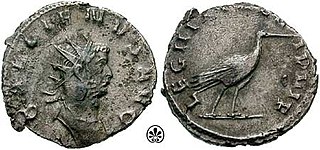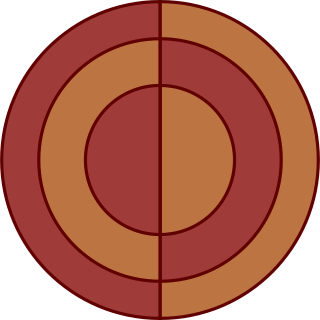
The Roman legion, the largest military unit of the Roman army, comprised 4,200 infantry and 300 equites (cavalry) in the period of the Roman Republic and 5,600 infantry and 200 auxilia in the period of the Roman Empire.

Legio II Augusta was a legion of the Imperial Roman army that was founded during the late Roman republic. Its emblems were the Capricornus, Pegasus, and Mars. It may have taken the name "Augusta" from a victory or reorganization that occurred during the reign of Augustus.

Legio XII Fulminata, also known as Paterna, Victrix, Antiqua, Certa Constans, and Galliena, was a legion of the Imperial Roman army. It was originally levied by Julius Caesar in 58 BC, and the legion accompanied him during the Gallic Wars until 49 BC. The unit was still guarding the Euphrates River crossing near Melitene at the beginning of the 5th century.

Legio VIII Augusta was one of the oldest legions of the Imperial Roman army.

Legio III Augusta was a legion of the Imperial Roman army. Its origin may have been the Republican 3rd Legion which served the general Pompey during his civil war against Gaius Julius Caesar. It supported the general Octavian in his civil war against Mark Antony. It was officially refounded in 30 BC, when Octavian achieved sole mastery of the Roman empire. In that year, it was deployed in the Roman province of Africa, where it remained until at least the late 4th century AD.

Legio XXII Deiotariana was a legion of the Imperial Roman army, founded ca. 48 BC and disbanded or destroyed during the Bar Kokhba revolt of 132–136. Its cognomen comes from Deiotarus, a Celtic king of Galatia. Its emblem is unknown.

Legio II Traiana, was a legion of the Imperial Roman army raised by emperor Trajan, along with XXX Ulpia Victrix, for the campaigns in Dacia. Records of the II Traiana Fortis have been recovered from Egypt dating to the middle of the 5th century. The legion's emblem was the demi-god Hercules.

Legio XIII Gemina, in English the 13th Twin Legion was a legion of the Imperial Roman army. It was one of Julius Caesar's key units in Gaul and in the civil war, and was the legion with which he crossed the Rubicon in January, perhaps the 10th, 49 BC. The legion appears to have still been in existence in the 5th century AD. Its symbol was the lion.

Legio III Cyrenaica, was a legion of the Imperial Roman army. The legion had its origins among the forces of Mark Antony during the civil wars of late first century BC. In the Imperial period it was stationed in Egypt, where it played a key role in campaigns against the Nubians and Jews. In the first century AD, it was usually located in Arabia Petraea. There are still records of the legion in Syria at the beginning of the 5th century. The legion symbol is unknown.

Legio XX Valeria Victrix, in English Twentieth Victorious Valeria Legion, was a legion of the Imperial Roman army.

Legio III Gallica was a legion of the Imperial Roman army. The cognomen Gallica suggests that its earliest recruits came from veterans of the Gallic legions of Gaius Julius Caesar, a supposition supported by its emblem, a bull, a symbol associated with Caesar. The legion was based for most of its existence at Raphanea, Roman Syria, and was still active in Egypt in the early 4th century.

Legio III Italica was a legion of the Imperial Roman army founded in 165 AD by the emperor Marcus Aurelius for his campaign against the Marcomanni tribe. The cognomen Italica suggests that the legion's original recruits were drawn for the defence of Italy. The legion was still active in Raetia and other provinces in the early 5th century.

Legio X Fretensis was a legion of the Imperial Roman army. It was founded by the young Gaius Octavius in 41/40 BC to fight during the period of civil war that started the dissolution of the Roman Republic. X Fretensis is then recorded to have existed at least until the 410s.
The comitatenses and later the palatini were the units of the field armies of the late Roman Empire. They were the soldiers that replaced the legionaries, who had formed the backbone of the Roman military since the late republic.

Legio V Macedonica was a Roman legion. It was probably originally levied in 43 BC by consul Gaius Vibius Pansa Caetronianus and Gaius Iulius Caesar Octavianus. It was based in the Balkan provinces of Macedonia, Moesia and Dacia. In the Notitia Dignitatum records from beginning of the fifth century, the legion was still stationed in Dacia, with detachments stationed in the east and Egypt.

The Legio I Maximiana was a comitatensis Roman legion, probably created by Emperor Diocletian in 296 or 297 AD. The legion was named after Maximianus, a colleague of Diocletian. The I Maximiana was formed together with II Flavia Constantia, to garrison the newly created province Thebaidos, in Aegyptus. As well as protect it from neighboring tribes. The legion is also known as Maximiana Thebanorum or Thebaeorum. Since no Legio I Maximiana is listed as being stationed at Thebes in the Notitia Dignitatum, the designation is interpreted more broadly as of the Thebaid in general. The cognomen Maximiana originated from Maximian, Diocletian's colleague. In 354, I Maximiana was located in Thrace, in the city of Adrianople. Thus it is likely that it fought in the Battle of Adrianople, in 378, when emperor Valens was defeated by Goths. According to Notitia Dignitatum, the I Maximiana Thebanorum was still under Thracian command at the start of the 5th century, while the I Maximiana was in Philae, under the dux Thebaidos. There exists also a Theban Legion in the legend of Saint Maurice from the 5th century. According to that tradition, this was a legion from Thebes that was ordered to move by Maximian. Thus it is sometimes related to I Maximiana Thebanorum. However, according to tradition, the Theban Legion of Saint Maurice was martyred in 286, while the I Maximiana was not founded until ten years later.

The Legio II Flavia Constantia was a comitatensis Roman legion, created by Diocletian or Galerius, probably in the years 293, 296 or 297.

Legio XI Claudia was a legion of the Imperial Roman army. The legion was levied by Julius Caesar for his campaign against the Nervii. XI Claudia dates back to the two legions recruited by Julius Caesar to invade Gallia in 58 BC, and it existed at least until the early 5th century, guarding lower Danube in Durostorum.
The Legio I Illyricorum was a Roman Legion stationed in Qasr el-Azraq and Palmyra; it is mentioned in the Notitia Dignitatum. According to many ancient sources, it was stationed within the Eastern Half of the Roman Empire, under emperor Aurelian.






